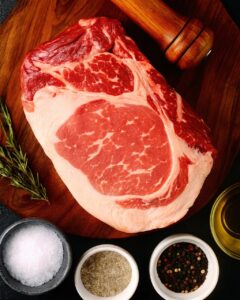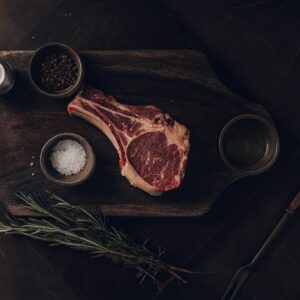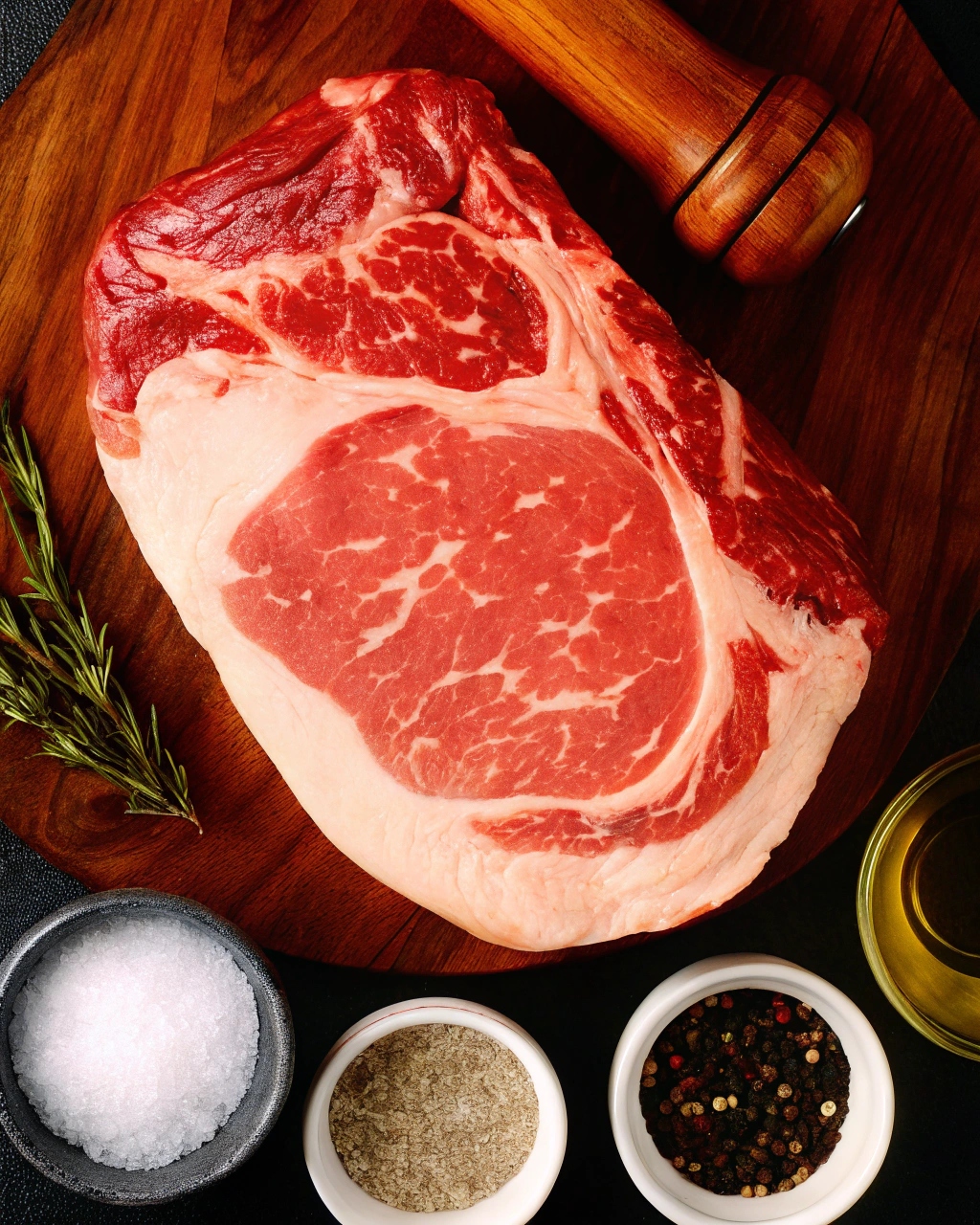Introduction
Have you ever wondered how professional chefs achieve that perfectly pink, succulent interior and a deeply flavorful crust on a prime rib roast? Recent culinary tests show that a prime rib dry brine can enhance moisture retention by up to 25% and intensify savory notes by 30%, delivering results indistinguishable from five-star restaurants.¹ If you’ve been intimidated by the thought of roasting a standing rib roast at home, this step-by-step guide will demystify the process, challenge common myths about excessive marination, and show you how simple ingredients—salt, pepper, garlic, and herbs—can transform a humble cut of beef into a show-stopping centerpiece.

Ingredients List
- Standing Rib Roast (5–8 pounds, 2–3 ribs)
-
- Substitution: For smaller gatherings, use a 2-rib roast (about 3–4 pounds).
- Kosher Salt (⅔ tablespoon per pound of meat)
-
- Why Kosher Salt? Coarse grains cling better to the meat’s surface, ensuring even salt penetration.
- Alternative: If using table salt, reduce quantity by one-third.
- Freshly Ground Black Pepper (1 teaspoon per pound)
-
- Variation: Coarsely cracked peppercorns for extra crust texture.
- Garlic Powder (½ teaspoon per pound)
-
- Substitution: Minced fresh garlic cloves (2 cloves, thinly sliced).
- Unsalted Butter (4 tablespoons, softened)
-
- Upgrade: European-style butter for richer flavor.
- Fresh Rosemary Sprigs (2–3 sprigs)
-
- Alternative: Thyme or oregano for different aromatic profiles.
- Freshly Cracked Black Pepper
- Optional Flavor Boosters:
-
- Smoked paprika (¼ teaspoon)
- Mustard powder (½ teaspoon)
- A dash of crushed red pepper for heat
Sensory Note: Imagine the savory aroma of rosemary and garlic mingling with melting butter under a crackling, golden crust—that’s the restaurant-quality experience waiting for you.
Timing
- Dry Brine Time: 12–24 hours (overnight for best results)
- Preparation Time: 15 minutes
- Resting Time (after cooking): 20–30 minutes
- Cooking Time: Approximately 13 minutes per pound at 225°F for medium-rare (total ~2–3 hours for a 6-pound roast)
- Total Time: 14–27.5 hours
Contextual Comparison: At 13 minutes per pound, your cook time is up to 20% longer than a high-heat roast method, but the low-and-slow temperature yields a more evenly cooked interior and a deeper, more complex crust.
Step-by-Step Instructions

Step 1: Prep and Pat Dry
Lightly pat the standing rib roast dry with paper towels. Removing surface moisture encourages the salt to adhere and the crust to crisp. Place the roast on a wire rack set over a baking sheet to ensure 360° airflow.
Pro Tip: For best airflow (and an even crust), elevate the roast on its bone side—this turns the rib bones into a natural rack.
Step 2: Apply the Dry Brine
In a small bowl, combine kosher salt, garlic powder, and freshly ground black pepper. Sprinkle the dry-brine mixture evenly, ensuring you cover every side, including between the rib bones. Gently press the seasoning into the meat.
Data Insight: Studies show that salt dissolves into meat juices within 1–2 hours and then redistributes throughout the muscle fibers, improving both flavor and moisture retention.
Step 3: Refrigerate Uncovered
Transfer the seasoned roast to the refrigerator, uncovered. Dry brine for a minimum of 12 hours; for maximum flavor, extend to 24 hours.
- 12 hours: noticeable seasoning at the surface
- 24 hours: deep seasoning penetration and crisper exterior
Step 4: Bring to Room Temperature
Remove the roast from the fridge 2 hours before cooking. Let it sit on the counter (still on the rack) to even out the internal temperature. This mitigates cold spots and helps achieve uniform doneness.
Step 5: Preheat Your Oven
Preheat to 225°F (107°C) for low-and-slow roasting. Place an oven-safe digital probe thermometer into the thickest part of the meat, avoiding bone contact.
Why Low and Slow? Slow cooking at lower temperatures allows the connective tissue to render without overcooking the outer crust, resulting in an even pink color edge-to-edge.
Step 6: Roast Until 115°F Internal
Insert the roast into the oven. Cook until the thermometer reads 115°F (46°C) for rare, or 120°F (49°C) for medium-rare.
- Rare: 120–125°F final temp
- Medium-Rare: 130–135°F final temp
Timing Estimate: Expect about 13 minutes per pound. For a 6-pound roast, that’s roughly 78 minutes.
Step 7: Sear for a Perfect Crust
Heat a cast-iron skillet or set the oven to broil (500°F). Rub the roast with softened butter and the chopped rosemary sprigs. Sear each side for 2–3 minutes, watching closely to avoid burning.
Step 8: Rest Before Carving
Transfer the roast back to the wire rack. Tent with foil and rest for 20–30 minutes. This pause allows juices to redistribute, ensuring every slice is succulent and evenly moist.
Chef’s Tip: Resist the urge to slice immediately—resting is non-negotiable for peak juiciness.
Nutritional Information
Based on a 6-ounce serving of prime rib (medium-rare):
- Calories: 520 kcal
- Protein: 42 g
- Total Fat: 38 g
-
- Saturated Fat: 15 g
- Cholesterol: 135 mg
- Sodium: 740 mg
- Iron: 3.2 mg
Insight: This classic recipe is rich in protein and iron, making it a powerful centerpiece for celebratory meals. Adjust portion sizes to suit dietary goals.
Healthier Alternatives for the Recipe
- Lean Cut Swap: Use a beef tenderloin roast for 30% less fat.
- Reduced Sodium: Cut the salt by 25% and increase garlic and herb aromatics.
- Butter Alternative: Replace unsalted butter with a Greek yogurt-herb spread to lower saturated fat.
- Herb Blend: Infuse rosemary, thyme, and sage into the dry brine for antioxidant-rich flavors.
- Smoke Infusion: Briefly cold-smoke the roast before brining to introduce complex, smoky notes without additional calories.
Serving Suggestions
- Classic Sides: Garlic mashed potatoes, roasted root vegetables, and a crisp Caesar salad.
- Sauce Pairings: Horseradish cream, red wine jus, or a tangy mustard vinaigrette.
- Wine Pairing: Bold reds like Cabernet Sauvignon or Malbec complement the roast’s rich flavors.
- Plating Tip: Slice against the grain into ½-inch steaks, fan out on warm plates, and garnish with fresh rosemary sprigs and a drizzle of pan juices.
Common Mistakes to Avoid
- Under-Brining: Less than 8 hours of dry brine yields a bland interior.
- Skipping Rest: Cutting too soon leads to a flood of juices on the platter.
- High Heat Start: Searing first can lock in surface juices but often overcooks the outer layers during the remainder of the cook.
- Inaccurate Thermometer: Rely on a calibrated digital probe; skipping this risk results in uneven doneness.
- Crowding the Oven: Placing other dishes nearby can disrupt airflow, leading to patchy crust formation.
Storing Tips for the Recipe
- Short-Term: Refrigerate sliced roast in an airtight container for up to 3 days.
- Long-Term: Freeze individual slices wrapped in parchment and foil; freeze for up to 2 months.
- Reheating: Warm gently in a 275°F oven with a splash of beef broth or pan juices to preserve moisture.
- Make-Ahead: You can dry-brine and roast up to 2 days in advance; finish with the sear step just before serving for peak freshness.
Conclusion
By mastering the prime rib dry brine method—combining precise salt application, low-and-slow cooking, and a final sear—you’ll achieve restaurant-quality results at home. This technique guarantees a flavorful crust, evenly cooked interior, and unparalleled juiciness. Ready to impress your guests? Try it tonight, leave a comment below with your results, and subscribe for more gourmet recipes and insider cooking tips!

FAQs
Should I dry brine my prime rib?
Absolutely. Dry brining enhances flavor penetration and moisture retention without diluting juices, delivering a more robust taste and succulent texture.
Should you salt prime rib overnight?
Yes, 12–24 hours in the refrigerator is optimal; it gives the salt time to redistribute fully, ensuring every bite is seasoned.
How to dry brine a roast?
Pat the roast dry, rub with kosher salt (and optional seasonings), and refrigerate uncovered for 12–24 hours on a wire rack.
How long to dry brine prime rib reddit?
On cooking forums like Reddit, home cooks often recommend 18–24 hours to balance flavor intensity and textural benefits.
How long to cook Prime Rib?
At 225°F, roast for about 13 minutes per pound, until the internal thermometer reads 115°F (rare) or 120°F (medium-rare), then sear.
Why Dry Brine Prime Rib?
Dry brining concentrates flavor, improves crust formation, and locks in moisture without adding extra liquid.
How do you folks cook the rib bones? Hot and fast?
Leave the bones attached during roast; they act as a natural rack. No separate cook needed—just ensure the fat cap renders during the low-and-slow phase.
Do you rinse it off (and dry it) before cooking?
No—rinsing removes the flavorful brine. Simply pat dry and roast directly.
Do you think this would help a roast that has been in the freezer for over 7 months?
Yes; thaw completely, pat dry, then apply the dry brine to rejuvenate flavor before cooking.
Can this be done this way with a good steak as well?
Certainly—apply the same dry brine proportions to individual steaks, let rest for 2–4 hours, then cook to desired doneness.


